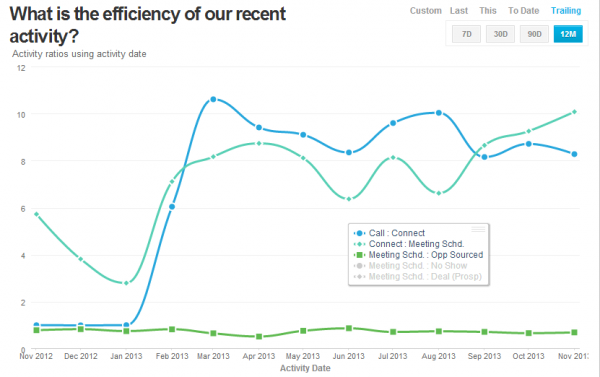
Call volume, or the number of dials made, is a top line measure of how your outbound prospecting team is doing. It is an indicator of each rep’s effort, not the caliber of their calls. But dials that lead to deals can only happen if your reps invest a lot of time into dialing. And the more calls your reps make, the more practice they get and the quicker they learn what works and what doesn’t.

 Author: Lindsay Kolowich is a Content Marketing Strategist at InsightSquared where she writes for their leading blog on Sales and Marketing Management Analytics. InsightSquared, invested in by Salesforce.com, is the #1 Salesforce Analytics product for small- and mid-sized businesses. They created a layer on top of Salesforce.com data that visualizes customers’ data and makes it easy to navigate and manipulate, providing sales managers & VPs with recommendations on how to improve their sales teams’ performance. Follow InsightSquared on Twitter @insightsquared.
Author: Lindsay Kolowich is a Content Marketing Strategist at InsightSquared where she writes for their leading blog on Sales and Marketing Management Analytics. InsightSquared, invested in by Salesforce.com, is the #1 Salesforce Analytics product for small- and mid-sized businesses. They created a layer on top of Salesforce.com data that visualizes customers’ data and makes it easy to navigate and manipulate, providing sales managers & VPs with recommendations on how to improve their sales teams’ performance. Follow InsightSquared on Twitter @insightsquared.
Using a clear, repeatable process that includes setting daily activity goals—like a set number of calls to hit—provides a solid, input-based foundation for employee productivity. Every day your reps know that, no matter what, they can make that many dials. Read on to learn the pros and cons of having a high call volume for your team.

Pros of high call volume
High call volume is generally a very good thing. It shows a big effort on the part of your reps and allows you to spot weaknesses in their execution more quickly.
It is good for conversions, too. If you see that 80 dials leads to 10 connects leads to 1 meeting, then your reps making fewer than 80 dials per day lowers the probability of conversion to a meeting to less than 1. Calculate how many dials it takes to book a meeting and eventually win a deal, and determine the number of required daily dials accordingly. If you start with a prospect pool that is too small, the number at the bottom of the funnel becomes irrelevant.
In some industries, startups are so ahead of their time that their prospecting team is responsible for not only making calls and setting up meetings, but also for educating the marketplace. They call hundreds of people every day who don’t even know they need their product yet. For this type of small company, a high call volume is necessary because they tend to have a much lower connect-to-meeting ratio. Most of the people they call are not open to learning about a new kind of product. The more dials sales reps in these industries make, the more they can touch and educate their target market.
Cons of high call volume
More dials does not necessarily mean more deals. To get more qualified opportunities and more deals, you need to track the dial : connect ratio for each rep and the team as a whole. If you just ask for more dials, your reps will dial more and perhaps compromise efficiency. They might be calling people who have no chance of ever converting, just to hit their daily numbers.
Set an expectation for how many calls they need to make per day, but don’t set it so high that they rush their conversations in order to hit the daily dial goal. Allow time for them to qualify businesses before wasting time calling one that is clearly not a good fit, or one that doesn’t even exist. If they need to hit an unfairly high dial quota, they might make the call anyway just to add to the tally.
Number of attempts
How many times should your reps call the same prospect without connecting before they give up? Connect rates vary significantly among industries, but you should think about how many dials you want your reps to make to a single prospect. There are industry standard touch models—usually either 6 or 8—that you can use as the early groundwork of your dialing plan, but you should keep track of your data and adjust this number as your develop your process.
Raw number of calls alone is not a great indicator of productivity or effectiveness. A vast majority of these calls are unlikely to be productive connections. Instead, managers should focus on activities ratios—the number of calls that lead to demos, trials, and ultimately deals.
This article was originally published by InsightSquared
 Author: Lindsay Kolowich is a Content Marketing Strategist at InsightSquared where she writes for their leading blog on Sales and Marketing Management Analytics. InsightSquared, invested in by Salesforce.com, is the #1 Salesforce Analytics product for small- and mid-sized businesses. They created a layer on top of Salesforce.com data that visualizes customers’ data and makes it easy to navigate and manipulate, providing sales managers & VPs with recommendations on how to improve their sales teams’ performance. Follow InsightSquared on Twitter @insightsquared.
Author: Lindsay Kolowich is a Content Marketing Strategist at InsightSquared where she writes for their leading blog on Sales and Marketing Management Analytics. InsightSquared, invested in by Salesforce.com, is the #1 Salesforce Analytics product for small- and mid-sized businesses. They created a layer on top of Salesforce.com data that visualizes customers’ data and makes it easy to navigate and manipulate, providing sales managers & VPs with recommendations on how to improve their sales teams’ performance. Follow InsightSquared on Twitter @insightsquared.
Published: January 27, 2014
3135 Views
3135 Views











